
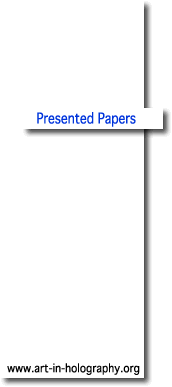
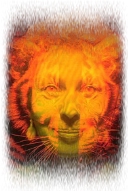
DEFINING TRADITIONS 1969 -1996. Living and working with holography
INTRODUCTION
The theme of this session of the Symposium made me feel a little uneasy. I had a problem seeing myself as a traditionalist, rather than an innovator. I still feel that to earn the label "creative" artists need to be original, and at the time I began making holograms I felt that to originate a new field was to do my job properly as an artist.
My art work began in a traditional way, as a painter. By around 1964 my paintings, for want of a better word, could be described as "optical symbolic". I was using systems of various kinds, optical illusions, colour and so on, to modulate the picture plane so that it no longer looked flat. But in particular it was my use of the graphic interference pattern or moiré that drew my attention to holography when I read about it in a newspaper in 1967.
The description in the newspaper, of the ways in which the interference pattern of light could do what I was already attempting to do in paint, led me to see a potential medium in holography. Paint had various restrictions. So I negotiated a Fellowship at this very University at Nottingham, where this Symposium is taking place. Here I began to experiment, making my first test plates in 1968. The old lab that I used is still here, on campus, like a time-travel machine. It is impossible to describe my feelings at re-discovering the same spaces that I worked in then. The gallery area where the current symposium exhibition is being held is like a palimpsest of my first exhibition, which was held in the same place. Sculptor Jerry Pethick, the inventor of the sand table, saw my first exhibition here in 1969. He brought news of Lloyd Cross and Editions Inc. I also knew about Bruce Nauman's show at Knoedler, but we did not know that artists Harriet Casdin-Silver and Carl Frederick Reutersward were also working with holography at that time.
EARLY WORK (1)
What I found with my early work in holography was that I became medium-led. I had to experiment. There was a whole new field out there, and it was not possible to continue with old preoccupations. It was necessary to start again. So I decided to treat each hologram as a prototype for future possible directions.
 One of my early holograms uses the light itself
as the subject. The hyperreal aspects of holography still draw
people to it, but I think that the most basic, primitive, pre-verbal,
reason for artists is the fact that we are working with light.
The light is primary. Having worked with it for a lifetime, for
a multiplicity of purposes, I feel that the underlying reason
why I am making holograms and not paintings is because they are
a purer way of connecting with those early, pre-verbal memories
that are experiences of light. With holography we can take that
primary experience of light, and form images. For me in the early
days this meant making art-historical comments, for example,
or making everyday things appear to float through each other.
The still lives took the hologram out of the lab into everyday
life, using the optical table as a domestic table. Hot Air made
the first use of what I called non-holograms, which were eventually
re-named shadowgrams. This piece is in the collection of the
Australian National Gallery as an "avant-garde classic",
which is a lovely contradiction in terms.
One of my early holograms uses the light itself
as the subject. The hyperreal aspects of holography still draw
people to it, but I think that the most basic, primitive, pre-verbal,
reason for artists is the fact that we are working with light.
The light is primary. Having worked with it for a lifetime, for
a multiplicity of purposes, I feel that the underlying reason
why I am making holograms and not paintings is because they are
a purer way of connecting with those early, pre-verbal memories
that are experiences of light. With holography we can take that
primary experience of light, and form images. For me in the early
days this meant making art-historical comments, for example,
or making everyday things appear to float through each other.
The still lives took the hologram out of the lab into everyday
life, using the optical table as a domestic table. Hot Air made
the first use of what I called non-holograms, which were eventually
re-named shadowgrams. This piece is in the collection of the
Australian National Gallery as an "avant-garde classic",
which is a lovely contradiction in terms.
I made what I thought of as a movie hologram in 1970. It was a triple exposure hologram with separated exposures, so that as you swivelled the plate one exposure would fade and the next would come up. I particularly loved the paradoxes in holography. A series of holograms of a loaf of bread taken over a number of days showed the bread looking dramatically rotten when it was actually fresh, and looking fresh when it had become rock-hard and solid enough to record. Clock, Mirror, Hypercube was a pseudoscopic hologram, time reversed, so that you see the back before you see the front of the image. You are like Alice, on the other side of the mirror. These were all laser viewable holograms, and they were all didactic, in that they were intended to be prototypes and to exclude personal experiences.
Another art fellowship followed at Strathclyde University in Scotland in 1971. Here I lived on baked beans, was granted half the cost of a laser from the Leverhulme Trust, and built my own lab in the Department of Architecture. At this time an article about my work was published in the journal Leonardo, and also in a book, Kinetic Art (2), and my work became known internationally. Britain's information services had issued official photographs of my work, and the show at the Lisson Gallery in London in 1970 had generated a great deal of publicity, but the Leonardo writing gave other artists the idea that they could make their own holograms. It was still quite a radical idea. For years I found that some scientists did not actually believe that I was making them myself.
I remember being visited by Anait during my time in Scotland. My fellowship lasted until 1973, and by then the content of my work was beginning to change. Bird in Box 1973 was the first piece I made that had an emotional, personal undercurrent. Only recently have I been able to admit that although officially it was a hologram of a complete closed surface, unofficially it was about my feelings as a scapegoated female artist in the architecture department, a boxed-in "bird". I was beginning to use holography for sociological comment, as in Brave New World and Third World. An interactive piece, Jigsaw, was a game in which players could discover for themselves that a hologram was an indivisible whole. It was quite an extraordinary experience to see the "many-in-one" manifest itself under your fingers as you played this game. Because the holograms were laser-lit I displayed them in darkened conditions, and in my final exhibition at Strathclyde housed them in a cardboard collapsible space quite appropriate for showing holograms, since holography has been described by Bohm as "an enfolded order".
AUSTRALIA
After leaving Scotland there were some
radical life experiences in the form of two very small babies,
and a move to another country, Australia (3). By 1978 I was able
to resume work where I had left off, following the same pattern
of art fellowships, this time at the Australian National University.
Any decision about setting up on my own, was postponed. I preferred
to work in an academic setting, pooling my equipment with scientists.
 More reflection tests
resulted in a process piece which was deliberately intended to
deteriorate over time. I sometimes wonder what it looks like
now, in the collection of the National Gallery of Victoria, Melbourne.
I made a piece against the commercialism of Xmas for an exhibition
of cards by artists, and carried out a full-colour collaboration,
Rainbow Rainbow, with scientists at the CSIRO Sydney. I also
made a reflection version of Jigsaw, which could be played outside
in the sun. By 1979 my work had became more cross -cultural and
about the land I found myself living in. Solar Markers is an
example (4). Mixed media works hybridised the holograms with
drawings and paintings, or the holograms themselves were scratched
and drawn into. Lattice, and the Unclear World and Greenhouse
series of holograms are examples of this. I found that the mixture
of media gave me increased scope for yet more socio-political
comment, and at the same time made my work easier to appreciate
for those used to more traditional media.
More reflection tests
resulted in a process piece which was deliberately intended to
deteriorate over time. I sometimes wonder what it looks like
now, in the collection of the National Gallery of Victoria, Melbourne.
I made a piece against the commercialism of Xmas for an exhibition
of cards by artists, and carried out a full-colour collaboration,
Rainbow Rainbow, with scientists at the CSIRO Sydney. I also
made a reflection version of Jigsaw, which could be played outside
in the sun. By 1979 my work had became more cross -cultural and
about the land I found myself living in. Solar Markers is an
example (4). Mixed media works hybridised the holograms with
drawings and paintings, or the holograms themselves were scratched
and drawn into. Lattice, and the Unclear World and Greenhouse
series of holograms are examples of this. I found that the mixture
of media gave me increased scope for yet more socio-political
comment, and at the same time made my work easier to appreciate
for those used to more traditional media.
As a preliminary to my retrospective exhibition Phases at the Museum of Holography New York, in 1980/8, I worked with Stephen Benton at Polaroid to make White Rainbow, which was mine, and Black Rainbow which was his. Stephen Benton is a creative scientist, the inventor of the WLT hologram, who had collaborated previously with Harriet Casdin-Silver and I think I benefited from this fact. I found him extremely intuitive to work with. As a learning experience being able to work with scientists has always been extremely valuable, but creatively, input is rare. White Rainbow was intended as the complement to Rainbow Rainbow. Phases was for me the definitive (and possibly last?) showing of my laser-lit work.
PULSED WORK
 Another
significant collaborator for me has been John Webster. In 1981
I returned to the UK and began to work with him at the Central
Electricity Generating Board, making holograms of people with
the pulsed laser he had developed. In Counting the Beats two
exposures a few microseconds apart form dark & light fringes
that give a direct visual readout of our inner & outer body
movements. From the vertical and horizontal directions of the
dark and light fringes you can see that I am shaking my head
in a "no" and he is nodding "yes". Tiresias
is a hologram of both of us occupying the same space, to form
a single androgynous being. The throbbing of the jugular vein
in a necklace pattern round the neck can be seen, and the pulse
of the heart, the traditional seat of the emotions. In 1982 I
set up a studio temporarily, in net curtain territory, in a garage
with a lift-up door. Many artists in the UK work at home, in
a bedroom or garage. In 1983 I moved to a permanent garage studio
which I was able to extend with the help of a Shearwater Award.
I have held teaching courses in this studio, and every couple
of years open it to the public during Dorset Art Week. It is
one of very few artist's holography studios in the world, and
is very modest.
Another
significant collaborator for me has been John Webster. In 1981
I returned to the UK and began to work with him at the Central
Electricity Generating Board, making holograms of people with
the pulsed laser he had developed. In Counting the Beats two
exposures a few microseconds apart form dark & light fringes
that give a direct visual readout of our inner & outer body
movements. From the vertical and horizontal directions of the
dark and light fringes you can see that I am shaking my head
in a "no" and he is nodding "yes". Tiresias
is a hologram of both of us occupying the same space, to form
a single androgynous being. The throbbing of the jugular vein
in a necklace pattern round the neck can be seen, and the pulse
of the heart, the traditional seat of the emotions. In 1982 I
set up a studio temporarily, in net curtain territory, in a garage
with a lift-up door. Many artists in the UK work at home, in
a bedroom or garage. In 1983 I moved to a permanent garage studio
which I was able to extend with the help of a Shearwater Award.
I have held teaching courses in this studio, and every couple
of years open it to the public during Dorset Art Week. It is
one of very few artist's holography studios in the world, and
is very modest.
Going back to 1983, more holograms were mastered at the CEGB and transferred in my own studio. The Conjugal Series shows male & female hands carrying out various actions. In modern holography we use the term "master" for the first laser lit hologram that we use to make white-light viewable copies from, rather like the relationship of film to print in photography. I have proposed that we alter the gender-loaded word of "master" to "matrix", because matrix is actually closer to the idea of the mould. In Facial Codes there is more interferometry of the emotions. Tigirl 1985, much to my amazement, became very well-known and liked.
THE COSMETIC SERIES
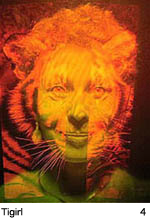 The
last two projects that I've been involved with are the Cosmetic
Series (5) and Cornucopia. The female Cosmetic Series evolved
out of a self-portrait combining a hologram and an underpainting
carefully registered with the hologram. The painting modifies
the hologram. I decided that I did not want to use myself as
a model, as I had done for many previous pieces, but to generate
myself through younger women, so all the women are around the
age of 23, around the age I felt myself to be inside. The women
were collaborators in the project to make themselves as beautiful
as possible. This was to make us feel as positive about ourselves
as we could.
The
last two projects that I've been involved with are the Cosmetic
Series (5) and Cornucopia. The female Cosmetic Series evolved
out of a self-portrait combining a hologram and an underpainting
carefully registered with the hologram. The painting modifies
the hologram. I decided that I did not want to use myself as
a model, as I had done for many previous pieces, but to generate
myself through younger women, so all the women are around the
age of 23, around the age I felt myself to be inside. The women
were collaborators in the project to make themselves as beautiful
as possible. This was to make us feel as positive about ourselves
as we could.  The
ostensible subject of the Cosmetic Series is the painted face
as a surface or mask. There were technical reasons in pulsed
holography for covering the skin surface with cosmetics, and
I was also frustrated at not being able to retouch the hologram.
There are aspects to some of these works that are holographic
- pre and post-swelling for instance, but there are numbers of
other aspects as well: the relationship with kitsch and identikit
painting. There is a documentary aspect - all the subjects have
their own names apart from Voiles and Black Jack. I thought of
them initially as "heads", like a sculptor, but the
hologram makes them into portraits. None of these people look
like this any more. They are records of people at a single stage
in their lives. Sophie for instance, is sadly no longer alive.
There is also an art-historical aspect, in that figurative paintings
have a relationship with past art. On the ideological plane these
are symbolic representations, in frozen or deep time. They are
static, centralised, hieratic images with neutral expressions.
The
ostensible subject of the Cosmetic Series is the painted face
as a surface or mask. There were technical reasons in pulsed
holography for covering the skin surface with cosmetics, and
I was also frustrated at not being able to retouch the hologram.
There are aspects to some of these works that are holographic
- pre and post-swelling for instance, but there are numbers of
other aspects as well: the relationship with kitsch and identikit
painting. There is a documentary aspect - all the subjects have
their own names apart from Voiles and Black Jack. I thought of
them initially as "heads", like a sculptor, but the
hologram makes them into portraits. None of these people look
like this any more. They are records of people at a single stage
in their lives. Sophie for instance, is sadly no longer alive.
There is also an art-historical aspect, in that figurative paintings
have a relationship with past art. On the ideological plane these
are symbolic representations, in frozen or deep time. They are
static, centralised, hieratic images with neutral expressions.
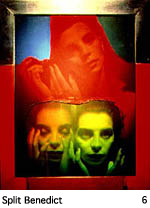 The
work on the master/matrix holograms was done in Paris with Anne
Marie Christakis, who had a pulsed laser, on an exchange basis.
I gave her finished pieces in exchange which she could then hang
in her museum. This work was shown there in 1986 in the exhibition
Mirage Image. During a second session at the Musée the
masters for Benedict Revealed and Split Benedict were made, and
also a start on the male series with Painted Stephan and Drawn
Stephan. This work was shown at ARTEC the international Biennale
in Nagoya, Japan. I felt that there should be a gender balance,
with both genders presented together as equals, but the male
series did not go as planned. The males ended up dominating as
usual. There are currently 12 men to 7 women. The male series
was done at the Royal College of Art as a PHD project (6).
The
work on the master/matrix holograms was done in Paris with Anne
Marie Christakis, who had a pulsed laser, on an exchange basis.
I gave her finished pieces in exchange which she could then hang
in her museum. This work was shown there in 1986 in the exhibition
Mirage Image. During a second session at the Musée the
masters for Benedict Revealed and Split Benedict were made, and
also a start on the male series with Painted Stephan and Drawn
Stephan. This work was shown at ARTEC the international Biennale
in Nagoya, Japan. I felt that there should be a gender balance,
with both genders presented together as equals, but the male
series did not go as planned. The males ended up dominating as
usual. There are currently 12 men to 7 women. The male series
was done at the Royal College of Art as a PHD project (6).
In the male series the psycho-therapeutic
angle changed. In the first two pieces Stephan is made glamorous,
like the women, but I felt that with the males this was the wrong
way to go. In the end the personal angle became not beautification,
but my coming to terms with male authority by using other stereotypes,
such as the soldier, the master artist, and so on. In the male
series I was painting faces in a different way, and hit a number
of problems, one of which was that men didn't have the experience
of "making-up" in 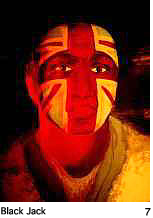 their
everyday lives way that the women had. When I suggested going
back in time, to a time when we were painting our bodies, probably
even before painting the walls of caves, they responded to that,
as in Pagan Paul and Pockel Paul. The male artist/authority figure
for me in the UK was Richard Hamilton. I respected him. He had
always been a technophile. We both got something out of this
collaboration. He showed the piece in his show at the Anthony
D'Offay Gallery. Part of the male series was shown at the Smiths
Gallery by Jonathan Ross but the whole series has not been shown
together yet. (Postscript: Later, in 1998, this work was featured
in "electronically yours" curated by Jasia Reichardt.
This show took place at the Tokyo Metropolitan Museum of Photography
under the auspices of the National Portrait Gallery, London.)
Black Jack is slightly different from the other pieces, in that
the painting that is not related to the hologram in the same
way. The hologram is of a white unemployed Brit with a black
Union Jack painted on his face, and underneath there is a black
man with a coloured Union Jack which shows through the black
Union Jack. It is about social & racial stereotyping. So
is Eddie Coloured.
their
everyday lives way that the women had. When I suggested going
back in time, to a time when we were painting our bodies, probably
even before painting the walls of caves, they responded to that,
as in Pagan Paul and Pockel Paul. The male artist/authority figure
for me in the UK was Richard Hamilton. I respected him. He had
always been a technophile. We both got something out of this
collaboration. He showed the piece in his show at the Anthony
D'Offay Gallery. Part of the male series was shown at the Smiths
Gallery by Jonathan Ross but the whole series has not been shown
together yet. (Postscript: Later, in 1998, this work was featured
in "electronically yours" curated by Jasia Reichardt.
This show took place at the Tokyo Metropolitan Museum of Photography
under the auspices of the National Portrait Gallery, London.)
Black Jack is slightly different from the other pieces, in that
the painting that is not related to the hologram in the same
way. The hologram is of a white unemployed Brit with a black
Union Jack painted on his face, and underneath there is a black
man with a coloured Union Jack which shows through the black
Union Jack. It is about social & racial stereotyping. So
is Eddie Coloured.
CORNUCOPIA
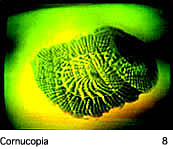 My solo exhibition Cornucopia at the Russell-Cotes
Museum in Bournemouth during the summer of 1996, showed some
more recent work. It included pieces like the Cornucopia animation
which lent its title to the series, or Rock Garden in which people
found the image by moving around a blue shell spiral. The Cornucopia
animated hologram is computer-morphed between two appropriated
end images to form a virtual object, something that doesn't exist.
The show was about "nature", that is the parts that
were least manipulated by humans. Rock Garden is about a sense
of place, my current habitat on the Dorset coast.
My solo exhibition Cornucopia at the Russell-Cotes
Museum in Bournemouth during the summer of 1996, showed some
more recent work. It included pieces like the Cornucopia animation
which lent its title to the series, or Rock Garden in which people
found the image by moving around a blue shell spiral. The Cornucopia
animated hologram is computer-morphed between two appropriated
end images to form a virtual object, something that doesn't exist.
The show was about "nature", that is the parts that
were least manipulated by humans. Rock Garden is about a sense
of place, my current habitat on the Dorset coast. 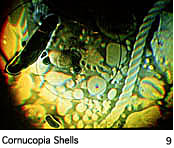 Some
aspects of natural abundance are explored, as in Cornucopia Shells,
Cornucopia Concrete in which concrete is made spectral by holography,
and Cornucopia Cauliflower, which is about female fulfilment.
I am interested to see whether this work could be used to define
Some
aspects of natural abundance are explored, as in Cornucopia Shells,
Cornucopia Concrete in which concrete is made spectral by holography,
and Cornucopia Cauliflower, which is about female fulfilment.
I am interested to see whether this work could be used to define
 female roles and
characteristics. Such notions as fertility, chaos, lack of rationality,
decoration are often seen negatively as such. In order to understand
and assert women's experiences, many contemporary women artists
have emphasised the importance of and links between, personal
and social political experience. This is important not just for
women but for the field as a whole.
female roles and
characteristics. Such notions as fertility, chaos, lack of rationality,
decoration are often seen negatively as such. In order to understand
and assert women's experiences, many contemporary women artists
have emphasised the importance of and links between, personal
and social political experience. This is important not just for
women but for the field as a whole.
 Other pieces in the show were Wrapped Flowers,
Enough Tyranny and the Enough Tyranny Travel Pack. An image of
binding together, Web, was combined with a hologram entitled
Blue, to make Web Blue Web. I have made a number of pieces with
the theme of web or binding. There have been cyclic, constant
themes that have persisted throughout my life. Many artists are
working from their life experience, one might even say "inner
life" experience. The themes or triggers are constant, but
the way they are presented differs with time. Curtain comes into
this same category. The curtain is closed, but it is planned
to be combined in future with a curtain opening onto blue, an
image of revelation. The only piece in the show which involved
a human being was "Pushing up the Daisies". It is an
epitaph, and an epitaph to this paper.
Other pieces in the show were Wrapped Flowers,
Enough Tyranny and the Enough Tyranny Travel Pack. An image of
binding together, Web, was combined with a hologram entitled
Blue, to make Web Blue Web. I have made a number of pieces with
the theme of web or binding. There have been cyclic, constant
themes that have persisted throughout my life. Many artists are
working from their life experience, one might even say "inner
life" experience. The themes or triggers are constant, but
the way they are presented differs with time. Curtain comes into
this same category. The curtain is closed, but it is planned
to be combined in future with a curtain opening onto blue, an
image of revelation. The only piece in the show which involved
a human being was "Pushing up the Daisies". It is an
epitaph, and an epitaph to this paper.
ACKNOWLEDGEMENTS
Many people and organisations have assisted and collaborated with me through the years, and I would like to take this opportunity to thank them all. On this occasion I would like thank Andy Pepper, the organiser of this symposium, and above all Posy Jackson, who founded the Museum of Holography New York in 1976. The number of artists using holography world-wide is still very small - at a generous estimate about 300 - and Posy has played a part in many of their lives.
NOTES and REFERENCES
1 "Any dispute as to whether Benyon is an important artist is premature, since her work in a completely unexplored medium is defining its own criteria." Science and Technology In Art Today. Jonathon Benthall. Thames and Hudson. pp 89 -93. 1972
2 1973 'Holography as an Art Medium.' Leonardo. Vol 6, No 1, pp 1 - 9 was re-printed in Kinetic Art: Theory and Practice. Dover. pp. 185 - 192. 1974.
3 Apparition. Holographic Art in Australia. Rebecca Coyle & Phillip Hayward. Power Publications, Sydney. Ch 2 "Margaret Benyon: The Founding of Holographic Art", pp 23 - 37. 1995
4 This was featured in the Creative Holography Index, the International Catalogue for Holography. Vol 1, Issue 1. Editor, Andrew Pepper. Monand Press, Bergisch Gladbach, Germany. 1993.
5 Art of the Electronic Age. Frank Popper. Thames and Hudson, pp 38 - 39. 1993
6 My PhD thesis How is Holography Art? is accessible through the British Library, Fax 0937 546286, quoting shelf No: DX 179873, and the Royal College of Art Library, London. 40,000 words. 1994.
ON-LINE REFERENCES
The Benyon Archive is the main on-line
source for information about my work
(see www.mbenyon.com ). This developed from the text and pictures on the HoloNet site (see www.holonet.khm.de ).
Some entries on my work can be found in the collection, exhibition and stereo sections of Jonathan Ross's website (see www.jrholocollection.com )
The Artists Database on the ICC site includes some work and a biography in the alphabetical index (see www.ntticc.or.jp) as does the G.R.A.M site, which also includes some text in the commentary and reference sections (see www.comm.uqam.ca/~GRAM/#pseudotarget.htm).
My work in the travelling exhibition Unfolding Light curated by Rene Barilleaux, can be seen on the MIT Museum site (see web.mit.edu/museum/exhibits/artist2.html) .
Also, an interview with Al Razutis from Wavefront Magazine, Fall 1986, can be found on Al's site (see www.holonet.khm.de/visual_alchemy/wavefront/wave13.html)
Images
| 1 | Hot
Air 1970 8" x 10" laser transmission hologram. Collection: Australian National Gallery. |
| 2 | Solar
Markers 1979 Reflection holograms approx. 1.5" x 1" mounted on rocks. Collection: MIT Museum, Boston |
| 3 | Tiresias 1981 In collaboration with John Webster 12" x 16" white light transmission hologram Collections: MIT Museum, Boston, USA. Victoria and Albert Museum, London |
| 4 | Tigirl 1985 33 x 30cm reflection hologram and reproduction Collections: MIT Museum Boston, USA; Museum für Holographie und Neue Visuelle Medien, Germany; and the Jonathan Ross Collection. |
| 6 | Sophie 1986 40 x 30cm reflection hologram & laser colour copy Collection: Musée de L'Holographie, Paris |
| 7 | Split
Benedict 1989 40 x 30cm collage of reduced image reflection holograms Collection: Musée de L'Holographie, Paris. Jonathan Ross Collection. |
| 8 | Black
Jack 1993 43 x 32 reflection hologram & laser colour copy Collection: Sanjou Laser Co, Beijing, China. |
| 9 | Cornucopia
Shells 1993 50 x 60cm open aperture transmission hologram & collaged film on acetate |
| 10 | Cornucopia
CauliFlower 1993 50 x 60cm open aperture transmission hologram |
| 11 | Curtain 1993 50 x 60cm reflection hologram |
| 12 | Cornucopia 1994/6 8" x 10" holographic stereogram. Computer morphed animation. Collection: Jonathan Ross Collection. |